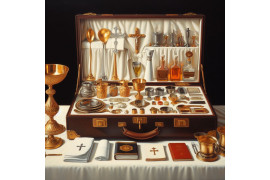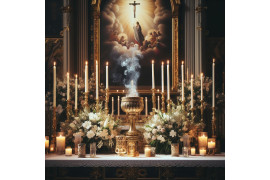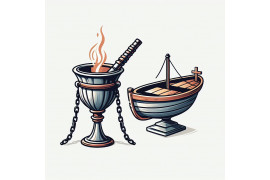A thurible and boat are essential items used in religious rituals to carry burning incense. These ceremonial tools hold great significance and symbolism, representing prayers rising to heaven and purifying the sacred space. The thurible, typically made of metal with a chain or rope for swinging, holds the burning incense while the boat serves as a vessel to transport additional incense. As the fragrant smoke fills the air, it enhances the spiritual atmosphere and engages the senses of those participating in the ritual. The use of a thurible and boat adds an element of reverence and solemnity to religious ceremonies, creating a profound experience for both participants and observers alike.
Types of Thuribles for Catholic Religious Practices
In Catholic religious practices, thuribles play a significant role in creating an atmosphere of reverence and spirituality. These vessels, also known as censers, are used to burn incense during various ceremonies and rituals. There are different types of thuribles that are commonly used in Catholic churches. Let's explore some of them:
Censer: The Most Common Type
The censer is the most common type of thurible used in Catholic religious practices. It consists of a container with a cover that is suspended from chains. The container holds the burning charcoal and incense, while the chains allow it to be swung back and forth during the ceremony. This swinging motion helps distribute the fragrant smoke throughout the space, symbolizing prayers ascending to heaven.
-
Pros:
-
Easy to use and handle.
-
Can hold a larger quantity of incense.
-
Provides a visually striking display when swung.
-
Cons:
-
Requires careful handling due to hot charcoal inside.
-
Chains may sometimes make noise during swinging.
Hand-held Thurible: A Smaller Version
Another type of thurible commonly used in Catholic ceremonies is the hand-held thurible. This smaller version is designed to be held by clergy members during processions or specific parts of the liturgy. It typically has a shorter chain compared to the censer but serves the same purpose of releasing fragrant smoke into the air.
-
Pros:
-
Portable and easy to carry.
-
Allows for precise control over where the smoke is directed.
-
Cons:
-
Holds less incense than a traditional censer.
-
Requires more frequent refilling.
Hanging Thurible: A Stationary Fixture
The hanging thurible differs from other types as it is a stationary fixture rather than being handheld or swung by chains. It is often found hanging from above in churches and cathedrals, with multiple chains attached to it. The swinging motion is achieved by manually pushing the thurible, causing it to swing back and forth.
-
Pros:
-
Provides a consistent swinging motion during ceremonies.
-
Can be larger, allowing for more incense to be burned.
-
Cons:
-
Requires physical effort to initiate the swinging motion.
-
Limited mobility compared to handheld versions.
These different types of thuribles offer flexibility and options for Catholic religious practices. Whether it's the traditional censer suspended from chains, the smaller hand-held version used during processions, or the stationary hanging thurible, each type serves its purpose in creating a sacred ambiance through fragrant smoke and symbolism.
Materials Used in Creating Thuribles and Boats
Thuribles and boats are essential liturgical objects used in Catholic religious practices. These items are crafted with specific materials to ensure durability, aesthetic appeal, and functionality. Let's explore the different materials commonly used in creating thuribles and boats.
Brass
Brass is a popular choice for crafting thuribles and boats due to its durability and aesthetic appeal. It is an alloy made primarily of copper and zinc, which gives it a beautiful golden appearance. The use of brass ensures that these liturgical objects can withstand the test of time, as they are often handled frequently during religious ceremonies.
Silver or Gold Plating
To add a touch of elegance and grandeur to thuribles and boats, silver or gold plating is often applied. This process involves coating the base material (usually brass) with a layer of silver or gold. The result is a stunning shine that enhances the visual appeal of these sacred objects. The silver or gold plating also provides protection against tarnishing, ensuring that the thurible or boat maintains its lustrous appearance for years to come.
Wood
While less common than brass or plated materials, wood is occasionally used in creating thuribles and boats, particularly for those seeking a more rustic or traditional look. Different types of wood may be employed, such as oak or mahogany, depending on personal preference and desired aesthetics. Wood offers a warm and natural feel to these liturgical objects, adding an element of simplicity to religious rituals.
Each option has its own unique advantages:
-
Brass provides durability and longevity.
-
Silver or gold plating adds elegance and sophistication.
-
Wood offers a more rustic or traditional appearance.
It's important to consider factors such as budget, personal taste, and intended usage when selecting the material for these liturgical objects. While brass is a popular choice due to its versatility and durability, silver or gold-plated thuribles and boats may be more suitable for special occasions or elaborate ceremonies.
Designs and Styles of Thuribles and Boats
Thuribles and boats come in various designs and styles to suit different preferences and aesthetic tastes. Let's explore some of the popular styles you can find in these ceremonial accessories.
Gothic Style
The Gothic style of thuribles and boats is known for its elaborate designs, featuring intricate carvings that showcase the craftsmanship of the artisans. These pieces often have chiseled brass or bronze finishes, giving them a regal and timeless appearance. The boat stand base may be adorned with ornate details such as crosses, floral motifs, or other religious symbols.
Baroque Style
In contrast to the Gothic style, the Baroque style of thuribles and boats is characterized by its ornate details and extravagant embellishments. These accessories often feature curves, scrolls, and intricate patterns that exude opulence. The boat stands in this style are designed to be visually striking, making use of intricate carvings or decorative elements like angels or cherubs.
Modern Style
For those who prefer a more minimalist approach, there are modern-style thuribles and boats available as well. These designs focus on simplicity and functionality while still maintaining their ceremonial significance. The emphasis is on clean lines, sleek shapes, and uncluttered aesthetics. Modern-style boat stands may have a sleek metal finish or be made from materials like glass or ceramic.
Each style has its own unique charm that can complement different types of religious ceremonies or personal preferences.
Here are some key features to consider when choosing a thurible or boat:
-
Chain Swing: Look for a swing that allows smooth movement so that incense can be distributed evenly.
-
Altar Cross Compatibility: Ensure that the thurible fits well with your altar cross if you plan to use them together.
-
Diameter: Consider the diameter of the thurible bowl to determine how much incense it can hold.
-
Product ID: Check the product ID to ensure you are purchasing the correct item.
When selecting a boat stand, keep in mind:
-
Material: Choose a material that suits your style and preference, such as brass, bronze, or other metals.
-
Design: Consider the design elements like carvings or motifs that match your overall aesthetic.
-
Size: Ensure that the boat stand is appropriately sized for your thurible and fits well on your altar.
Remember to take into account both the practicality and visual appeal of these accessories when making your selection. Whether you prefer the intricate details of Gothic or Baroque styles or the sleek simplicity of modern designs, there is a thurible and boat combination out there that will suit your needs.
Importance of Incense Boats in Catholic Liturgical Rites
Incense boats play a significant role in Catholic liturgical rites, serving as vessels to hold incense grains before they are placed into the thurible. These boats facilitate the easy transportation of incense during ceremonies and are often adorned with decorative elements that reflect religious symbolism.
Hold the incense grains before they are placed into the thurible
One important function of an incense boat is to hold the incense grains before they are placed into the thurible. The thurible, also known as a censer, is a metal container used for burning incense during religious ceremonies. Before the grains can be burned, they need to be transferred from their storage container or bag into the thurible. This is where the incense boat comes in handy.
The design of an incense boat typically includes a small scoop or spoon-like structure attached to its body. This scoop allows for controlled and precise handling of the delicate incense grains. By using an incense boat, priests and altar servers can ensure that no precious grains are wasted or accidentally spilled during this process.
Facilitate easy transportation of incense during ceremonies
During Catholic liturgical rites, it is common to use incense at various points throughout the ceremony. The smoke produced by burning incense is believed to symbolize prayers rising to heaven and purifying the space in which it is used. To ensure a smooth flow of these rituals, it is essential to have a convenient way to transport and distribute the incense.
Incense boats fulfill this purpose by providing a dedicated vessel specifically designed for holding and transporting incense grains. They often feature handles or chains that allow them to be easily carried or passed from one person to another. This makes it effortless for priests and altar servers to move around with the necessary materials during religious services.
Adorned with decorative elements that reflect religious symbolism
In addition to their practical function, incense boats are often adorned with decorative elements that reflect religious symbolism. These designs can vary depending on the specific traditions and customs of the Catholic Church. Some incense boats may feature intricate engravings or symbols representing key aspects of the faith.
For example, an incense boat might be embellished with images of saints, angels, or crosses. These decorations serve as a visual reminder of the spiritual significance of the ritual and help create a reverent atmosphere during worship. The use of such symbolic imagery enhances the overall aesthetic appeal of the liturgical rites and adds a touch of sacred beauty to the ceremony.
Different Types of Incense Boats for Various Catholic Ceremonies
In Catholic ceremonies, the use of incense is an essential part of the liturgical rites. To hold and distribute the fragrant smoke, a special vessel called an incense boat or thurible is used. These boats come in various designs and shapes, each serving a specific purpose during different religious rituals.
Boat-shaped Incense Holder
One common type of incense boat is the boat-shaped holder. As the name suggests, this design resembles a miniature boat and adds a symbolic touch to the ceremony. The boat-shaped incense holder often features intricate details and craftsmanship, making it visually appealing as it glides through the air during processions.
Bowl-shaped Incense Holder
Another popular choice is the bowl-shaped incense holder. This type of vessel provides a simple yet practical solution for holding incense grains. It typically consists of a deep bowl with high sides to prevent any spillage while carrying or swinging it during rituals. The bowl shape allows for easy access to the incense grains when refilling or distributing them.
Artistic Incense Boat
For those seeking something more unique and artistic, there are specially crafted vessels known as artistic incense boats. These boats showcase intricate artwork, ranging from religious symbols to ornate patterns, adding an aesthetic element to the ceremony. Artistic incense boats are often made by skilled artisans who pour their creativity into every detail.
When choosing an incense boat for Catholic ceremonies, several factors come into play:
-
Size: Consider the size of your congregation and space available in your church when selecting an incense boat. A larger boat may be necessary for bigger gatherings to ensure adequate distribution of smoke throughout the space.
-
Material: Incense boats can be made from various materials such as brass, silver-plated metal, or even precious metals like gold or silver. Each material offers its own unique aesthetic and durability.
-
Style: The style of the incense boat should align with the overall decor and ambiance of your church. Whether you prefer a traditional design or a more modern artistic piece, there are options to suit every taste.
-
Functionality: Ensure that the incense boat is easy to handle and use. Some boats may have additional features such as handles or chains for better control during swinging motions.
Appreciating the Beauty and Symbolism of Thuribles and Boats
We discussed different types of thuribles used, such as hanging censers and hand-held ones, highlighting their purpose in enhancing the liturgical experience. We delved into the materials employed in creating these sacred vessels, ranging from brass to silver and gold-plated options.
Furthermore, we examined the diverse designs and styles of thuribles and boats, showcasing how they can be intricately crafted with ornate detailing or feature simpler yet elegant forms. We also emphasized the importance of incense boats in Catholic liturgical rites, explaining how they hold the fragrant incense that symbolizes prayers rising to heaven. Lastly, we explored various types of incense boats used for different Catholic ceremonies.
As you continue your journey to understand these cherished items better, we encourage you to dive deeper into each topic covered in this blog post. Explore the historical context behind specific designs, or learn about notable artisans who have contributed to this rich tradition. By immersing yourself in these details, you can gain a greater appreciation for the beauty and symbolism that thuribles and boats bring to Catholic religious practices.
FAQs
Can I use any type of incense in a thurible?
Yes, you can use various types of incense in a thurible. The most common type is church-grade resin incense made from natural materials like frankincense or myrrh. However, there are also other options available, such as floral or herbal blends that can add a unique scent to your liturgical experience.
How do I properly clean a thurible?
To clean a thurible after use, it is recommended to remove any remaining charcoal or ash carefully. Gently wipe down the interior with a soft cloth or sponge, ensuring that all residue is removed. For the exterior, use a mild soap and water solution to clean the surface, taking care not to damage any decorative elements. Dry thoroughly before storing.
Can I personalize a thurible or boat?
Yes, it is possible to personalize a thurible or boat. Many artisans offer custom engraving services, allowing you to add names, dates, or special symbols that hold personal significance. This can make your thurible or boat even more meaningful and serve as a cherished keepsake for generations to come.
Are there specific rituals associated with using a thurible and boat?
Yes, there are specific rituals associated with using a thurible and boat in Catholic liturgical practices. The priest or deacon typically prepares the incense by placing it in the thurible within the sanctuary. During Mass or other ceremonies, the incense is then blessed before being used to cense the altar, sacred objects, and congregation members as an act of reverence.
Where can I purchase a thurible and boat?
Thuribles and boats can be purchased from various religious supply stores, both online and offline. You may find them available at specialty shops that cater specifically to Catholic liturgical items. It's recommended to research reputable sellers who offer high-quality products to ensure authenticity and craftsmanship when making your purchase decision.



